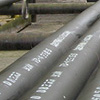

Hunan Standard Steel Co.,Ltd es uno de los miembros de Husteel Industry Group, como fabricante profesional de tuberías y accesorios de tubería de acero dulce, que tiene un sistema completo de producción ... Más
Fábrica GrupoDifference Ultrasonic Flaw Detector and X-ray Flaw Detector
fecha:2016-07-30
Vista:2511
The method of using ultrasound to detect instrument called ultrasonic flaw detector. Its principle is: when the ultrasonic wave propagation in the detected material changes in the acoustic properties and the internal organization of the material have a certain effect on the propagation of ultrasonic waves through the ultrasonic affected degree and condition detection understanding material properties and structural changes of technology called ultrasonic testing. Ultrasonic testing methods typically penetrating, pulse reflection method, serial method. Penetrating ability, depth of up to several meters;
x-rays can not penetrate conventional visible light through the material. The strength of its ability to penetrate, and x-ray wavelengths and is penetrated material density and thickness. x-ray wavelength shorter, the greater penetration; the lower the density, the thinner the thickness of the x-rays to penetrate more easily. In practice, the value of the voltage V balls tube (kV) to determine the size of the x-ray penetration (ie, x-ray quality), and to the unit of time through the x-ray current (mA) and the time the product Representative x-ray amount. The maximum thickness can be measured with the x-ray intensity, generally metal thickness of 0.3 m or less;
The advantages of ultrasonic testing than X-ray flaw detection:
It has high sensitivity, short cycle, low cost, flexible, high efficiency, harmless to human body and so on;
Ultrasonic testing disadvantages compared to X-ray detection of:
On the work surface smoothing requirements, requirements experienced inspectors to identify the type of defect, the defect does not intuitive;
Ultrasonic testing is suitable for large thickness parts inspection.
x-rays can not penetrate conventional visible light through the material. The strength of its ability to penetrate, and x-ray wavelengths and is penetrated material density and thickness. x-ray wavelength shorter, the greater penetration; the lower the density, the thinner the thickness of the x-rays to penetrate more easily. In practice, the value of the voltage V balls tube (kV) to determine the size of the x-ray penetration (ie, x-ray quality), and to the unit of time through the x-ray current (mA) and the time the product Representative x-ray amount. The maximum thickness can be measured with the x-ray intensity, generally metal thickness of 0.3 m or less;
The advantages of ultrasonic testing than X-ray flaw detection:
It has high sensitivity, short cycle, low cost, flexible, high efficiency, harmless to human body and so on;
Ultrasonic testing disadvantages compared to X-ray detection of:
On the work surface smoothing requirements, requirements experienced inspectors to identify the type of defect, the defect does not intuitive;
Ultrasonic testing is suitable for large thickness parts inspection.
- Anterior : Defects of Electric Resistance Welding
- próximo : The Basic Principle of Eddy Current Testing
























